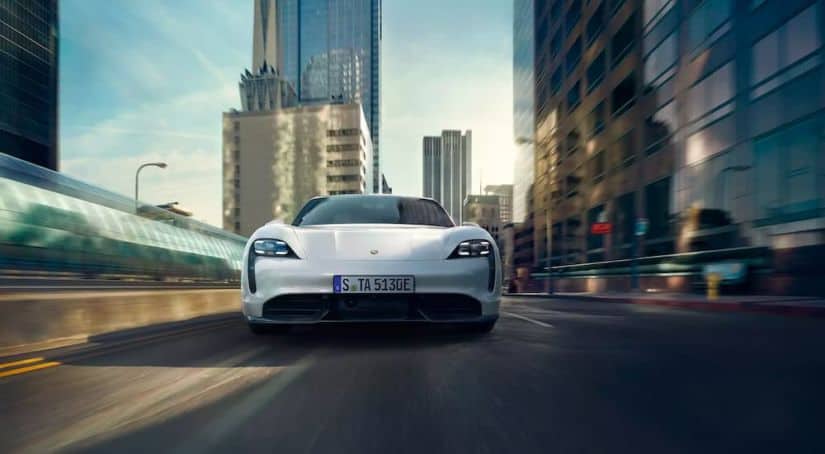Hello there! If you already know everything there is to know about the various Porsche models, if you amaze your friends by quoting them various 0 to 60 times and have flown to Germany to drive your Porsche home yourself, then this isn’t for you. You already know what you need to know, so go enjoy the rest of your day. If you’re interested in what Porsche has to offer, but immediately overwhelmed by the options in their lineup, then this is absolutely for you.
One look at the variety of different models and submodels available from Porsche makes one thing very clear: they have too much going on. I’m sure fans of Porsche are more than happy to have so many different vehicles to choose from, but I believe there is such a thing as too many options. Nevertheless, I’m going to take a crack at working through the various models available and help give you a sense of what each one has to offer.
The Porsche 718
Let’s start things off with the Porsche 718, one of the sleekest sports cars on the road. The 718 Cayman is essentially the entry-level for Porsche sports cars, offering a fantastic driving experience with plenty of power and performance. You’ll also see a 718 Cayman S, which has a more powerful engine – the standard Cayman offers 300 hp while the Cayman S delivers 350 hp.
Then there’s the 718 Boxster, which gives you the same excellent power and performance as the Cayman but as a convertible. So if you want a standard coupe, choose Cayman; if you prefer a convertible, go with Boxster. Next up, there are two 718 T models (the 718 Cayman T and 718 Boxster T), which are basically higher performance versions of the first two types. Where the standard models can go from 0 to 60 in 4.9 seconds, the T models can do it in just 4.5 seconds.
If you want truly incredible performance, however, then consider a 718 GTS 4.0 model, available as either a Cayman or Boxster. These have 4.0L 6-cylinder horizontally-opposed engines that deliver 394 hp for 0 to 60 speeds of 3.8 seconds. There’s also a Cayman GT4 model, which offers a similarly powerful engine that actually delivers 414 hp and an amazing driving experience. Finally, you can choose a 718 Spyder, a gorgeous two-seater convertible model with a 414 hp engine that can go from 0 to 60 in 3.7 seconds.

The Porsche 911
Next up, we have the legendary Porsche 911, probably the car most people think of when they hear the word “Porsche.” Much like the 718, it’s available in a lot of different models, so let’s go through them all. First up, you’ll see a few general terms that you should know. The “Carrera” is the base model for the 911, while the “Cabriolet” is simply the convertible version, much like the Cayman and Boxster variants of the 718.
With that in mind, you’ll see versions of various 911 models with an “S,” these are the latest-generation models for the 911, while those without the “S” are from the previous generation. Similarly, a “4” in the name indicates it’s a four-wheel drive model rather than a standard rear-wheel drive. The 911 is also available with a Targa top, which is similar to a convertible but leaves a part of the roof behind the seats with a rear window.
You’ll see models such as a “Porsche 911 Carrera” or “911 Carrera S Cabriolet,” and now you know what all of those names mean. The 911 is also available as a Turbo model, which offers better performance than the standard ones, with similar naming conventions. For comparison, a standard Porsche 911 Carrera has 379 hp and can go from 0 to 60 in 4.0 seconds, while the 911 Turbo S has 640 hp and can go from 0 to 60 in just 2.6 seconds.
The Porsche Taycan
Fortunately, from here on out, the naming conventions and options are (mostly) simpler than with the 718 and the 911. The Porsche Taycan is an all-electric four-door model that has received a lot of attention for its impressive power platform and incredible design. Don’t be fooled by the sedan look and shape or the fact that it’s an electric vehicle – this is a Porsche through and through with the insane performance that you’d expect. The 800-volt battery in the Taycan is revolutionizing the way a lot of people think about EV design, with quick charging and speeds that will definitely push your back against the driver’s seat.
The standard Taycan 4S can go from 0 to 60 in 3.8 seconds and gets up to 522 hp, with a top track speed of 155 mph. If you want even better performance, then consider the Taycan Turbo, which goes from 0 to 60 in just 3.0 seconds, has 670 hp, and a top track speed of 161 mph. Finally, there is the Taycan Turbo S, the ultimate expression of all-electric Porsche design, which can go from 0 to 60 in 2.6 seconds, gets up to 750 hp, and has a top track speed of 161 mph.

The Porsche Panamera
If you like the four-door looks of the Porsche Taycan, but you’re not ready to make the jump to an electric vehicle, then consider the Panamera. This is a sedan model that gives you excellent interior space with a distinctly Porsche design that places a clear emphasis on performance. There are, of course, many different models available for the Panamera, which can seem confusing at first.
The standard Porsche Panamera has a sedan design and rear-wheel drive, while the Panamera 4 has four-wheel drive instead. You can also choose an “Executive” model that has a longer wheelbase to give you more legroom inside, or the “Sport Turismo” station wagon (I know how strange it is to have “Porsche” and “station wagon” in the same paragraph, but here we are). There is also an E-Hybrid model with a hybrid engine and a performance-oriented GTS model available.
For really incredible performance, you can choose a Turbo model of the Porsche Panamera, which is available in all three body styles. So while your options might seem a bit overwhelming at first, it’s really just three styles with different levels of performance.
The Porsche Macan
Next up, we have the first of two SUVs available from Porsche: the Macan. Intended as the entry-level model, it’s a compact crossover available at a very reasonable price and is incredibly popular for that reason. You have four different versions to choose from here, and each one is essentially a step up in terms of performance. Here’s a simple comparison between them:
Macan: 248 hp, 0-60 in 6.3 seconds
Macan S: 348 hp, 0-60 in 5.1 seconds
Macan GTS: 375 hp, 0-60 in 4.7 seconds
Macan Turbo: 434 hp, 0-60 in 4.3 seconds
So, as you can see, the different names are really all about the performance you get with them. But at the end of the day, even the standard Macan is still a Porsche.
The Porsche Cayenne
Finally, we have the Porsche Cayenne, a midsize luxury SUV with everything you’d expect in such a vehicle paired with incredible performance and power. There are quite a few different models available, though they start with a standard Cayenne SUV that has 335 hp and goes from 0 to 60 in 5.9 seconds. Then there’s a Cayenne E-Hybrid, with a hybrid engine that offers 455 hp and goes from 0 to 60 in just 4.7 seconds.
Next up is the latest Cayenne S model, with 434 hp and 0 to 60 in 4.9 seconds, along with an impressive Cayenne GTS that has 453 hp and can go from 0 to 60 in 4.5 seconds. There’s a Cayenne Turbo, designed for performance, with 541 hp and the ability to go from 0 to 60 in 3.9 seconds, as well as a Cayenne Turbo S E-Hybrid with 670 hp and 0 to 60 in just 3.6 seconds.
Just in case that all wasn’t confusing enough, you can also get a Cayenne Coupe version with all of these same names and engine options. The Coupe is still a four-door model, but it’s smaller than the standard Cayenne SUV. So if you like the engines in the Cayenne, but you want something a little sportier, then check out a Coupe.
You should now have a pretty good sense of which Porsche model would be best for you. Even if you’re not sure which specific options to choose, this should at least point you in the right direction. Good luck, and happy driving!



